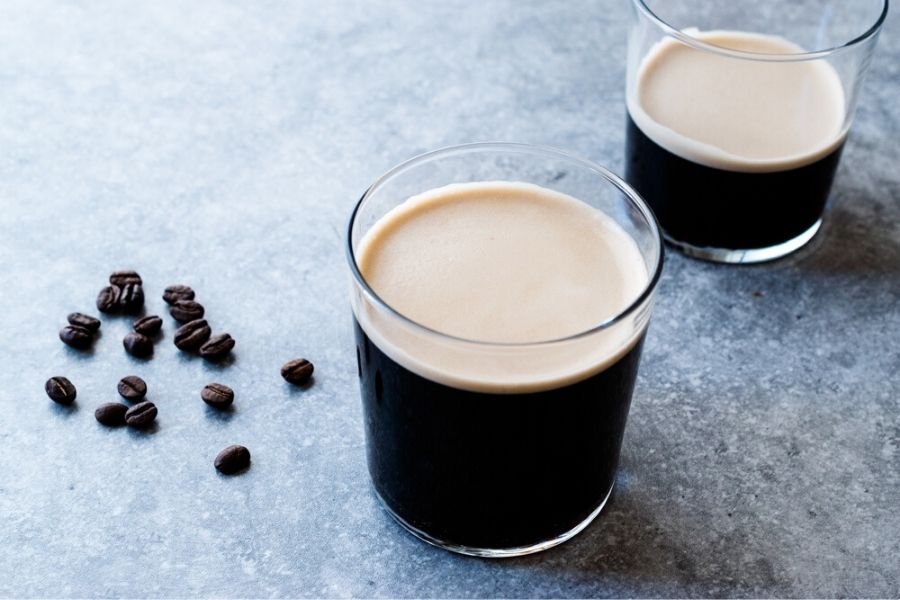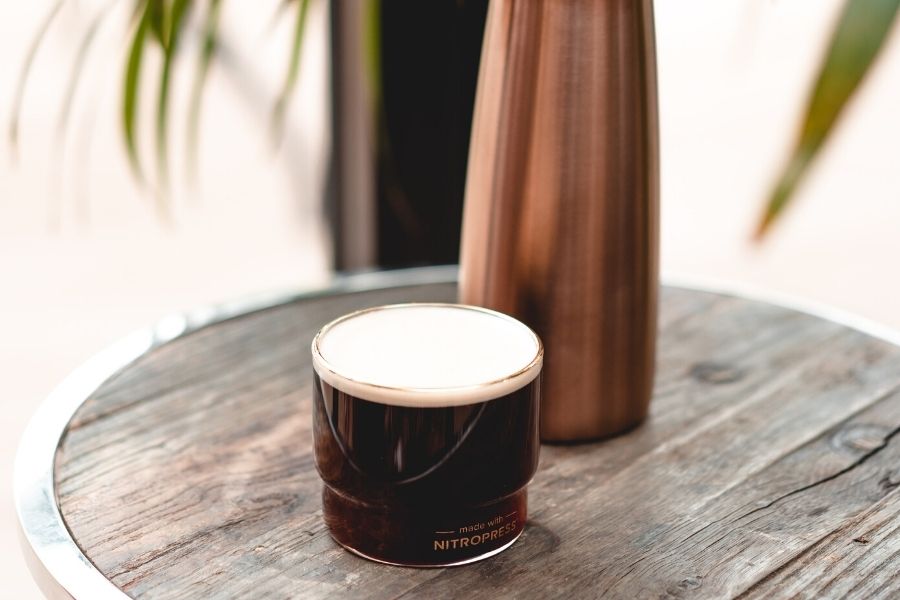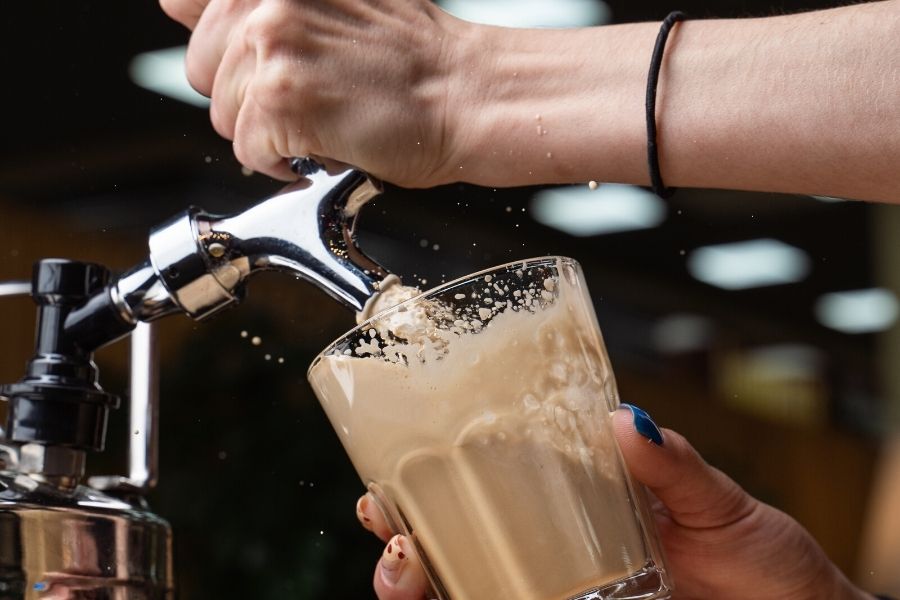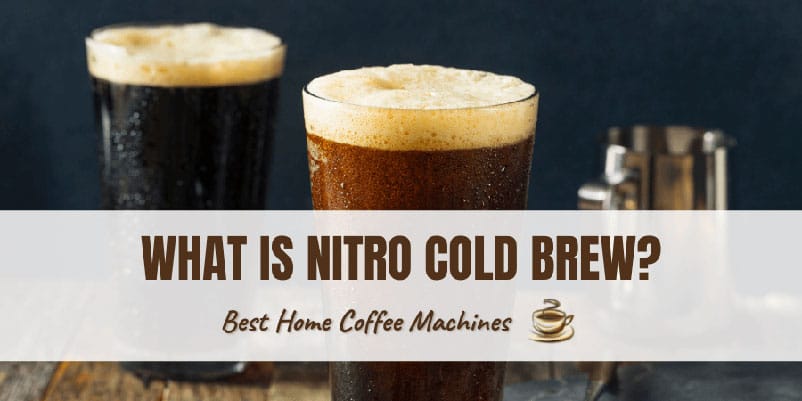What is a Nitro Cold Brew? Coffee’s Cool Kid Explained
Here’s the thing about commercial coffee: It’s subject to trends, and sometimes those trends are gimmicks. We see it all the time, with notable examples being Starbucks’ short-lived but much-hyped Unicorn Frappuccino, and the battle for the strongest coffee in the world.
When it hit cafes, nitro cold brew coffee was, quite literally, the coolest coffee around with scores of people claiming that it was the smoothest coffee ever. But what made it so special? Is it healthy, and should you try one? And most importantly, what is nitro cold brew coffee anyway?
This article covers all this and more. Here’s what you can expect:

What Is Nitro Coffee and How’s It Made?
I don’t know about you, but when I hear the words nitro coffee, I immediately think of energy drinks, protein shakes, and Need for Speed video games. There’s something about the name that makes it sound so breakneck.
This impression is off the mark though as nitro coffee is simply cold brew with added nitrogen gas for texture. I know what you’re thinking — added nitrogen doesn’t sound healthy, but don’t panic. I’ll show you exactly how this brewing method is perfectly safe later on in this article.
Before we get to that, let’s get to know Nitro a bit better.
It Starts With Cold Brewing
I won’t go into much detail here because we covered the basics in our cold brewer buyer’s guide, but in case you missed it, here’s the TDLR:
Cold brewing is a specialized brewing method in which coffee is made slowly but surely rather than forcefully. Grounds are left to steep in cold or room temperature water for anywhere between 12 and 24 hours. This painfully slow extraction is said to be healthier, sweeter, and smoother and is regarded as one of the best ways to brew.
Nitro is cold brewed coffee. It’s not a brewing method on its own, but rather, an extra, specialized step in the cold brewing process.
Fun fact: Cold brew and iced coffee are not interchangeable. Learn the differences (and see which one we think is better) here.
Then Add Nitrogen
There are various ways to create nitro coffee, though the principle is the same. Once a cold brew is prepared, nitrogen gas, dispensed from pressurized canisters, is pumped and infused into the brew.
Some cafes use inline nitrogen infusers. This complicated set-up has a higher initial cost but cuts down on effort. The idea of it is the same as a bar’s taps. Infusers are installed within a cafe’s existing draft system so when baristas open the taps, the flat cold brew mixes with nitrogen. Baristas can easily serve nitro cold brew coffee fresh from the tap this way.
This video show a nitro set-up at work:
Pre-infusing kegs take a little bit more time, but they’re cost-effective. Here, nitrogen gas is added to flat coffee and left to infuse, sometimes for days.
Though nitro coffee has a lot of chemistry behind it and installing a set-up for mass production requires solid research and planning, the chemistry is relatively simple.
When nitrogen is added to coffee it reacts in much the same way fizzy drinks are carbonated. When gas is added to coffee, it creates cascading bubbles that add texture and, therefore, alter your perception of the coffee’s profile.
To perfectly envision this, compare the taste of flat, dull soda to fresh soda. Or, flat beer to fresh beer. While the drink is the same and the flavor isn’t really changing, the bubbles change how you experience it.
Nitrogen bubbles, which are smaller than carbon dioxide bubbles, add a texture to cold brew that’s similar to milk, making it thicker, velvety, and silky smooth but without the weight of dairy. It’s a great cream or milk substitute for those who don’t enjoy black java.
If you’d like to know if you can make nitro coffee at home, read on. We’ll cover that shortly.
A Look at Nitro Cold Brew History
It’s an excellent, original, and unconventional idea that took the world by storm. So who invented nitro cold brew?
Honestly, no one knows. There is much debate over who nitrogenated coffee first and where it originated.
Cuvee Coffee claims that CEO Mike McKim invented nitro cold brew in 2005 after being inspired by a coffee house that served java on tap. In 2011, while drinking beer, he had a new idea: to add bubbles. It’s said that he debuted his creation in 2012 in Austin, Texas.
But Chemical and Engineering News reports that nitro cold brew was created by Nate Armbrust, in Portland, Oregon, in 2013. His story is that he simply wanted to add fizz to cold brew, but after realizing that carbonated coffee wouldn’t work, he turned to nitrogen.
Others go as far back as the 1950s, crediting Michael Ash as the true discoverer of nitro, as he accidentally realized its properties while figuring out a way to extend Guinness’s shelf life. Though he didn’t invent nitrogenated coffee, without his handiwork, we wouldn’t have it.
Even though nitro coffee’s exact origins are disputed, one thing is certain: it’s a relatively new invention that only rose to prominence in the mid-2010s. It didn’t need much time to make its mark, though. Now, it’s one of the most sought-after craft coffees and it changed the way we see and experience cold java.

Is Nitro Coffee Healthy?
Nitrogen is tricky because how you consume it matters. The majority of the air we breathe is made up of nitrogen, so it’s not deadly to inhale at its standard 79 percent level, but breathing in pure nitrogen could knock you out — even kill you — in seconds.
Liquid nitrogen can be safely consumed in food. In fact, it’s been used in the food industry for ages as a fast and effective way of freezing and preserving perishables. And the use of liquid nitrogen in food challenges and creative cooking has grown in popularity, especially in online videos and cooking shows.
That said, the FDA has said not to consume food or drinks prepared with liquid nitrogen when served because the cold can cause severe damage to your skin and internal organs.
If the FDA flagged it, is nitro coffee bad for you?
Not because nitro doesn’t make use of liquid nitrogen but nitrogen gas, which is safe for consumption. It’s also an inert gas and therefore isn’t affected or altered by other gases. As a gas, there’s no evidence that suggests it’s unhealthy when added to foods or drinks.
Because nitrogen gas has no nutritional value on its own, nitro coffee is equal to any regular (or cold brew) coffee, with the same benefits, and drawbacks.
Is Nitro Coffee Stronger?
Nitrogen does not affect caffeine content and it won’t physically alter a coffee’s boldness either, so claiming that nitro is stronger than other coffees is simply incorrect.
Even so, there are two considerations.
First, nitrogen adds texture, so your perception of a coffee’s boldness will be altered. A flat coffee, and then the same one pumped with nitrogen, will seemingly have two completely different flavor profiles. The bubbles will also physically change the smoothness of a coffee, making it creamier and softer. So, enjoying nitro is not about the taste as much as it is the experience.
Second, remember that nitro coffee is made with a cold brew, which is healthier than regular coffee. It’s also a coffee concentrate that could have higher levels of caffeine, depending on its dilution.

Can I Make Nitro Coffee at Home?
Brewing your own nitro coffee isn’t as difficult as it sounds, but it will take a while and you have to invest in a cream whipper canister or a nitro coffee brewing keg. Let’s face it, most people don’t have these things lying around. You’ll also need a cold brewer, a coffee grinder, and nitrogen cartridges.
First Make Your Cold Brew
Making cold brew coffee is literally the easiest thing in the world, it just takes time so do this in advance.
The exact method varies depending on your cold brewer, but it’s fairly straightforward:
Step 1: Grind your beans. You can do this to your liking but a medium-coarse to coarse grind of dark roast beans is recommended.
Step 2: Add grounds to your cold brewer, and then add cool or cold water. There isn’t a magic formula to follow, though the coffee concentrate standard is 1:4 coffee to water. You can adjust this according to the strength you’re after. For an extra smooth experience, use purified water.
Step 3: Seal your cold brewer and… wait. Cold brew coffee generally takes 12 hours, so a good idea is to set it aside overnight. You can brew it on your countertop, or undisturbed in your fridge if you prefer.
Step 4: When your cold brew is ready, run it through a coffee filter to remove the loose grinds. Most cold brewers come with filters, so you can also simply decant your cold brew concentrate from the brewer.
Add Nitrogen With a Cream Whipper
If you’re using a cream whipper:
Step 1: Add your (diluted) cold brew to the canister, then replace the cap of the whipper. Make sure it’s tightly sealed or else it won’t pressurize.
Step 2: Charge your canister with one or two nitrogen oxide cartridges. Shake your canister for 30 seconds, then let it stand for at least five minutes.
Step 3: Discharge excess gas by gently pressing the trigger of your cream whipper.
Step 4: Charge it with two more cartridges and shake for another 30 seconds then leave it to settle for an hour before dispensing your nitrogenated cold brew.
This is a simple, affordable method with no learning curve, though the drawback is that nitrogen cartridges don’t last all that long and will have to be replaced frequently.

Use a Mini-Keg Nitro Coffee Brewer
If all else fails, you can invest in a mini-keg for easy nitro cold brewing. These coffee makers are rigged to brew, infuse, and dispense nitro coffee much like cafes.
Operation varies depending on the model you buy, so there may be a learning curve, but generally speaking, nitro brewers are easy to get the hang of. The initial cost is higher but it’s a worthy investment if you’re a fan of nitro coffee and want to make it often.
Conclusion
Nitro cold brews are an excellent way to enjoy coffee. Adding nitrogen bubbles enhances the coffee’s texture and alters the way you experience its flavor profile.
While nitro is not stronger or healthier than regular coffee, it’s likely the smoothest coffee you’ll ever drink. It’s easy to make at home and is certainly worth looking into if you’re a craft brewer.
Have you tried nitro coffee yet? If not, give this unique joe a shot!
Nitro Cold Brew FAQs
Your burning questions about all things nitro…
What Is Nitro Cold Brew with Sweet Cream?
Nitro cold brew with sweet cream is a coffee served at Starbucks. Nitro coffee is topped with the cafe chain’s vanilla sweet cream.
Is Nitro Coffee Bad for You?
No, it’s isn’t any better or worse for you than normal cold brew coffee. Plus, because the process means you don’t need extra sugar to make it palatable, it may even be better for people who take sugar in their joe.
What’s Special About Nitro Cold Brew?
Nitro cold brew is made differently and you get a different taste experience. The fluffiness of the head makes it look somewhat like a glass of Guinness beer, and the taste is thick and creamy like a Guinness too, but it’s all about the coffee here.





